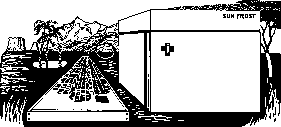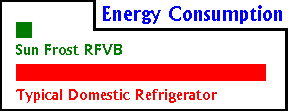|
|
|
Vaccine Storage |


- Rustproof cabinet and hardware
- Evaporator is unexposed - cannot be punctured during defrosting
- All copper cooling system prevents corrosion
- Condenser is easy to clean and minimally effected by dust and cobwebs
- Compressor is the only moving part - no fans are necessary
For the past 12 years Sun Frost refrigerators/freezers have been used in over 50 countries and have an excellent track record. Sun Frost units are very ruggedly constructed and will provide many years of reliable operation, even in the harshest environments.
The sole moving part in the SUN FROST RFVB refrigerator is a hermetically sealed compressor. The brushless motor used in the DC models eliminates periodic servicing. If servicing is ever necessary, the simplicity of the cooling system and the accessibility of the compressor make it a simple matter.
Life expectancy of a compressor is lowered primarily by high condenser and oil temperatures. The SUN FROST refrigerator, with its top mounted cooling system, allows room for air to freely circulate and effectively cool the compressor and over sized condenser. Conventional cooling systems, mounted in confined spaces on the side or below the refrigerator, will run considerably hotter, lowering compressor life.
The evaporator in the RFVB is protected by a fiberglass liner and cannot be punctured while defrosting, a common problem in many manual defrost refrigerators.
Also contributing to the longevity of the cooling system is the compressor's low percentage run time, only 19% in a 32° C (90° F) room.
The low energy consumption of the RFVB allows the use of a smaller and more reliable battery for the funds expended. In a photovoltaic refrigerator system, the battery bank is the component with the shortest expected life. A battery may last from 2 to 15 years, depending on the quality of the battery and how it is used and maintained. Battery life is extended by decreasing the degree to which the batteries are discharged.
The SUN FROST RFVB provides a means of storing vaccines and medical supplies without the use of fossil fuels. Not only is the need for a fuel supply eliminated, but the unit operates more reliably than kerosene powered refrigerators.

The refrigerator is typically powered by a photovoltaic charged battery bank. This reliable power source is dependent only on sunlight, which is in abundance in most developing nations. Alternatively, the system's batteries may also be charged by wind, hydro power, or a small generator. If portability is important, the refrigerator may be run by car or truck batteries.
In areas where utility power is intermittent but where it is important to maintain reliable refrigeration, the system's batteries may be powered by a small battery charger powered by utility power.
The cost of a solar power system is typically more than the cost of the refrigerator, so efficiency is of prime importance in reducing system costs. As a result of the low energy consumption of the Sun Frost RFVB, the cost of the power system will be reduced by more than US$700.00. Our RFVB Vaccine Storage unit is the most efficient DC refrigerator tested and approved by the World Health Organization (WHO).
The SUN FROST RFVB refrigerator employs unique design innovations to achieve its exceptionally low energy consumption. The heart of the system is a highly efficient compressor and condenser. Top mounting the cooling system lowers the energy consumption in two ways: (1) heat gain into the cabinet is reduced and (2) the lower condenser temperature increases the efficiency of the cooling system.
 The
walls of the RFVB contain four to six inches of polyurethane foam
insulation - the best insulation commercially available. Unlike many other
refrigerators, the insulating value of the walls of the RFVB are not
lowered by metal supports between the inner and outer cases.
The
walls of the RFVB contain four to six inches of polyurethane foam
insulation - the best insulation commercially available. Unlike many other
refrigerators, the insulating value of the walls of the RFVB are not
lowered by metal supports between the inner and outer cases.
The top mounted condenser on the SUN FROST RFVB is accessible and easy to clean, allowing the cooling system to continue running efficiently. The efficiency of the cooling system is further increased by eliminating the need for fans, which consume energy and generate unwanted heat and noise. Furthermore, dust and cobwebs which collect on the intricate surface of the back or bottom mounted condenser of conventional refrigerators reduce the effectiveness of their cooling systems.
To produce one amp. hour* of electrical energy per day in the U.S. requires an investment of $45.00 in a PV system. In a developing country this cost may be considerably higher.
When making ice the highly efficient SUN FROST RFVB typically saves 25 amp. hours per day when compared to the average refrigerator tested by the World Health Organization. This increased efficiency translates to a savings of over $1000.00 in the PV power system.
The relatively large freezer in the RFVB can easily hold 12 kilograms of ice. This ice may be transferred to the refrigerator section if the cooling system is not in operation due to refrigerator failure, loss of power, or an exceptionally long overcast period.
The 12 kilograms of ice now stored in the super-insulated refrigerator section will keep the stored vaccines cold for approximately nine days. If the system's batteries are low because of extremely bad weather, this nine day period should be sufficient to let the batteries recharge. Without ice storage, it would be necessary to purchase additional batteries to maintain the vaccines during prolonged overcast conditions.
When defrosting is needed, it is fast and easy. Just turn off the refrigerator for about 30 minutes. Since ice forms only on the flat, easily cleaned surfaces, it comes off in large pieces. There are no irregular shapes and ducts to grip and hold the ice, and no water to mop up.
The temperature of the refrigerator section is tightly controlled for vaccine storage. The large capacity freezer section can produce 2 kilograms of ice per day in a 43° C (110° F) environment running only 42% of the time. Ice is produced very efficiently in the RFVB; only 6 amp. hours are typically consumed to produce one kilogram of ice. Competing models use nearly twice as much energy for ice production.
The evaporator design contributes significantly to the efficiency of ice production. Containers being frozen make direct contact with the evaporator molded into the floor of the freezer section. A second evaporator in the ceiling of the freezer effectively cools the contents of the freezer by convection.
In a chest type freezer, it is difficult to make direct contact with the evaporator for effective conductive cooling. Also, in a chest type freezer convection is less effective because the evaporator cannot be mounted above the freezer.
The freezer section of the RFVB is isolated from the refrigerator compartment by three inches of polyurethane insulation. This feature prevents stored vaccines from being heated when warm water is placed in the freezer, a problem in refrigerators of conventional design.
In addition to efficiency, the RFVB design offers convenience. Stored vaccines are much more accessible than they are in chest models. Health workers generally find the vertical design much more acceptable.
SUN FROST refrigerators have proved themselves reliable. Over the past 12 years they have been installed in over 50 developing countries and have held up under the harshest conditions. For critical applications, far from supporting infrastructure, from Borneo to Botswana, Sun Frost refrigerators have delivered consistently dependable performance day in and day out.
| Freezer | volume 34 liters (1.2 cu ft) |
66 cm (26 in) wide by 10.2 cm (4 in) high by 50.8 cm (20 in) deep |
|
| Refrigerator | volume 55 liters (1.8 cu ft) |
66 cm (26 in) wide by 16.5 cm (6.5 in) high by 50.8 cm (20 in) deep |
|
| The World Health Organization measures internal volume with specific size containers & container spacing. Using that method, the RFVB has a 30 liter capacity. | |||
| Shipping weight crated for over seas shipment 95 kilograms (208 pounds) | |||
| Shipping volume crated for over seas shipment 0.7 cubic meters (25 cubic feet) | |||
| Room Temperature | 21° C (70° F) | 32° C (90° F) | 43° C (110° F) |
| Energy Consumption (12 volt) | 13 amp. hours/day | 19 amp. hours/day | 34 amp. hours/day |
| Energy Consumption (12 volt) making 2 kg ice/day |
36 amp. hours/day | 50 amp. hours/day | |
| Refrigerator Temperature | 3° C (38° F) | 3° C (38° F) | 3° C (38° F) |
| Freezer Temperature | -11° C (12° F) | -9° C (15° F) | -5° C (23° F) |
| Running Current | 4.5 amps for 12 volt system, 2.3 amps for 24 volt system | ||
| Starting Current | 15 amps for 12 volt system, 7.5 amps for 24 volt system | ||
| Wiring should be designed for 15 amp. load for 12 volt system, 7.5 amps for 24 volt system | |||
Back to top of page.
| Knot Work |  |
Web Weaving |